Our exhibition Body Beautiful: Diversity on the Catwalk, was inspired in part by the National Museum’s involvement with Edinburgh College of Art’s Diversity Network.
The Diversity Network was formed in collaboration with All Walks Beyond the Catwalk, an initiative which challenges the fashion industry’s dependence on unhealthy body ideals. The Diversity Network strives to teach students – as future stakeholders in the fashion industry – the importance of celebrating diversity within their approach to design and image-making.
The ethos of ‘emotionally considerate design’ underpins the ECA fashion curriculum, encouraging students to challenge existing beauty standards. For their second year ‘Designing Diversity’ module, students work with a chosen muse to explore the connection between garment and wearer. This year they also collaborated with Fashion Communication students from Heriot-Watt University, who produced fashion zines encapsulating the design ethos of each look.
Four students – Sophie Walton, Dolores Zhou, Rosie Lindsley and Katie Griffith Morgan – had their work on display as part of our exhibition, Body Beautiful: Diversity on the Catwalk, while others participated in filming for our introductory exhibition film, and many of the zines were in the exhibition for visitors to read. As the exhibition set out to explore how and to what extent the industry is championing alternative ideals of beauty, and also considers how the industry can create sustainable change, it felt particularly important that it should include the voices of the next generation of young designers. The first museum exhibition to address diversity on the catwalk worldwide, it also reflects ECA’s position as leaders in education around diversity.
The Student’s design statements below illustrate just how broad their influences and inspirations were – highlighting the myriad of ways in which diversity and inclusivity in fashion can be understood.
Designer: Sophie Walton
Muse: Jaylene Mbararia
Jaylene was born in Nairobi, Kenya and is of Kenyan, German & Ugandan ancestry. I am inspired by Maasai tribes’ scarification, combined with traditional and contemporary tailoring and Jaylene’s memories of growing up wearing a school uniform.
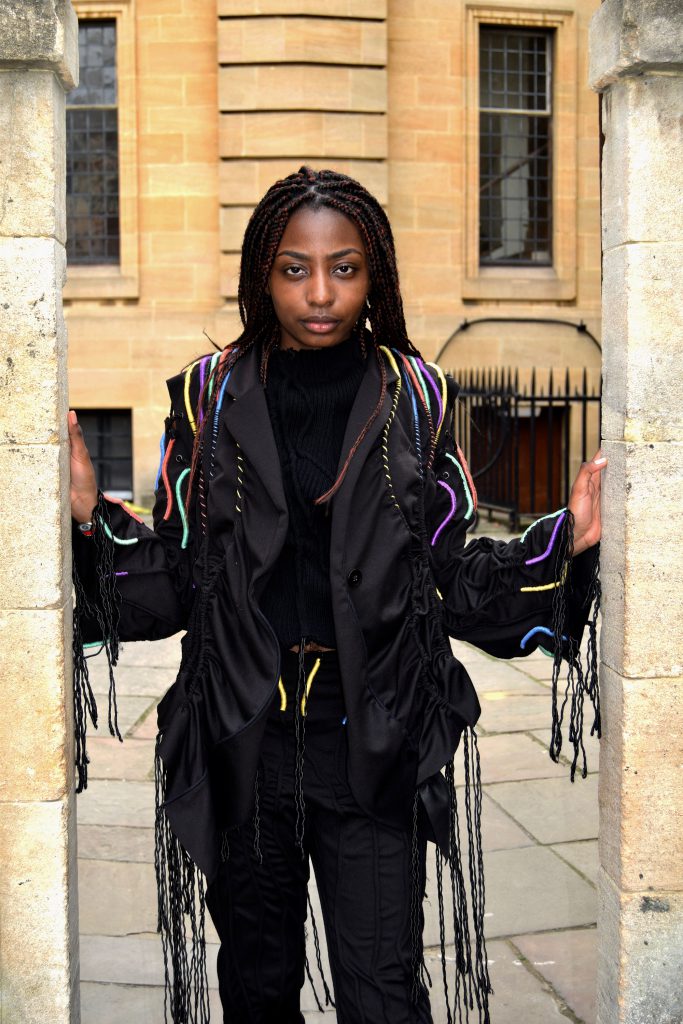
Jacket, trousers and top by Sophie Walton
Ponte, rib jersey, Edinburgh, 2019
Heriot Watt Collaboration: Eloise Cassels
Designer: Skye Bending
I’m fascinated with the history and traditions of Mexico and wanted to contrast bright, vibrant, traditional Mexico with the forward-thinking, alternative ways of Berlin. I’m interested in Berlin in the 1980s, when punk culture was at a high due to the revolution.
Hulipil is a traditional garment worn by indigenous women in Mexico; heavy-handed with bright floral embroidery. I wanted to design a bolder and more contemporary version, mixing in eighties’ punk graffiti band covers to explore surface and texture development.
Muse: Maike Venzlaff Ruiz

Cutaway dress, top and trousers, by Skye Bending
Neoprene, Compact Stretch Polyester, Edinburgh, 2019
Heriot Watt Collaboration: Carys McMonagle, Imogen Stubbs
Designer: Calvin Blackburn
Muse: Curtis Gallagher
Raised on the outskirts of Clackmannanshire, close to the Ochil Hills, Curtis grew up with an instilled love for hillwalking and camping, and a strong sense of pride in the history of his Celtic landscape. Having struggled with mental health issues, Curtis sees the value in escapism as a therapeutic tool.
Focusing on the notion of ‘safe-spaces’ (both physical and imagined) I wanted to blur the lines between fantasy and reality in order to create an expression of emotional catharsis. Symbolically folding, collapsing and wrapping around the body – the garment is reimagined as a protective talisman, sheltering the wearer from the nihilism of daily life.
Draped jacket, kilt and trousers, by Calvin Blackburn
Boiled wool and viscose knit, stretch chiffon, stretch cotton, Edinburgh 2019
Heriot Watt Collaboration: Riia Rosa Mattila
Designer: Ellie Brown
Muse: May & Robyn Taylor (Identical Twins)
I am trying to challenge working-class appropriation in the fashion industry, and I wanted my muse to be someone with first-hand experience of this social group in my area of Middlesbrough and Teeside. My design is informed by the stereotype of someone from a low-income background, incorporating streetwear and sportswear vibes, and inspired by working-class aspects of Teesside life, such as the steelworks.
My print and laser cut patterns are inspired by the Burberry ‘chav panic’ of 2004, when the luxury goods group saw a sharp decline in UK sales owing to the popularity of its trademark check among lower-income social groups.
Double layered tracksuit, by Ellie Brown
Heriot Watt Collaboration:Katie Bell, Jayne Dodds
Dolores Zhou
Muse:Yang Ze Wang
My concept explores the development of contemporary Chinese social culture through the surreal street scene in China, demonstrating the conflict between the traditional and the avant-garde.
The ruffles and gathers are inspired by plastic bags seen on the streets of Shenzhen in China, the knots and ties reflect the expectation of stable social status within the city, while the broken lines represent the disorder underneath. The print on modern scuba fabrics reflects the tradition in China of hanging pickled and salted fish alongside their washing.
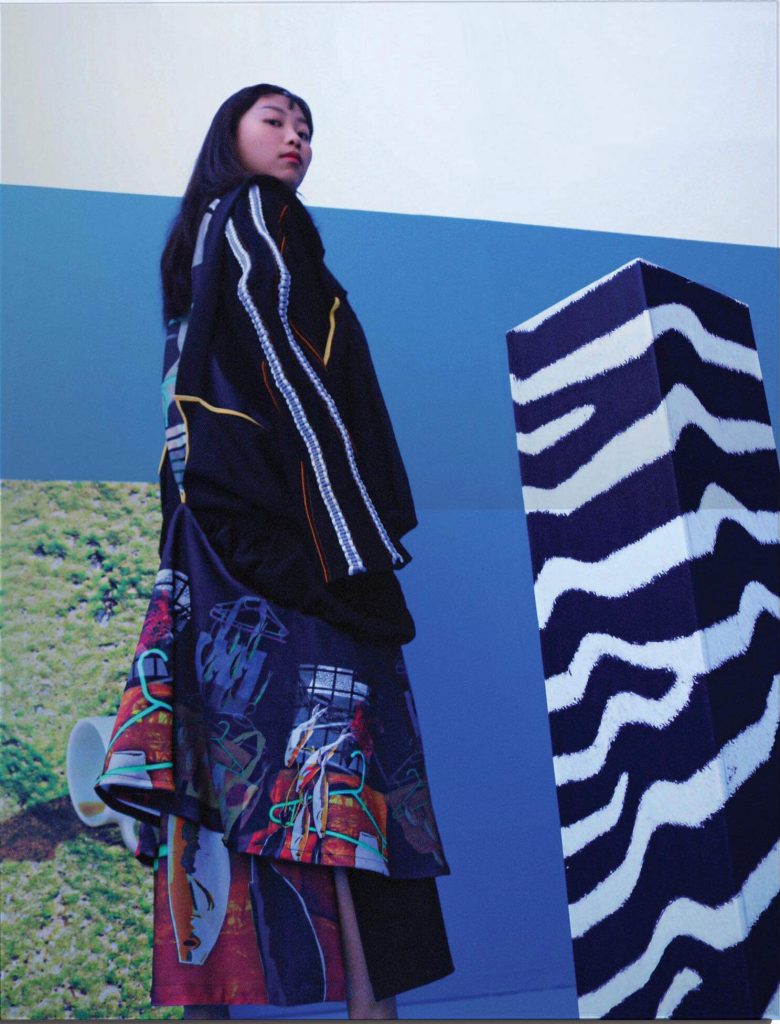
Dress and coat, by Dolores Zhou
Neoprene, Edinburgh, 2019
Heriot Watt Collaboration:Scott Bennett, photography by Sophie Corbett
Rosie Lindsley
Muse: Katie May Anderson
Katie is queer, and also has a deep Christian faith. These two worlds are often at odds with each other, so I wanted to explore the relationship between Katie’s personal androgynous style and her queer and religious identities.
I have combined the sharp edges of menswear with romantic feminine drapery drawn from pre-Raphaelite art, blurring gender boundaries. Techniques such as draping reflect Katie’s religious upbringing, and I created bold patterns inspired by the stained glass windows in Katie’s church.
Jacket and trousers, by Rosie Lindsley
Neoprene, cotton rib, Edinburgh, 2019
Heriot Watt Collaboration: Camille Lemoine
Designer: Katie Griffith Morgan
Muse: Isabella Neergaard-Petersen
Isabella is my modern day Pre-Raphaelite muse. Inspired by romantic draping, I created an outfit that does not aim to hide or constrict, but celebrates the contours and curves of the female form. Isabella is studying at Edinburgh University, lives in Copenhagen and has Danish, Nigerian and Irish heritage – the epitome of a modern multicultural woman. She is not afraid to voice her opinions and be unapologetically herself.
Isabella is a size 16, which is under-represented on the catwalk. I developed my print in response to the barrage of toxic imagery of unattainable body standards we are exposed to in the media. I wanted to create a different form of imagery, equally arresting, but this time celebrating the beauty of the female form and representing a fearless 21st century woman.
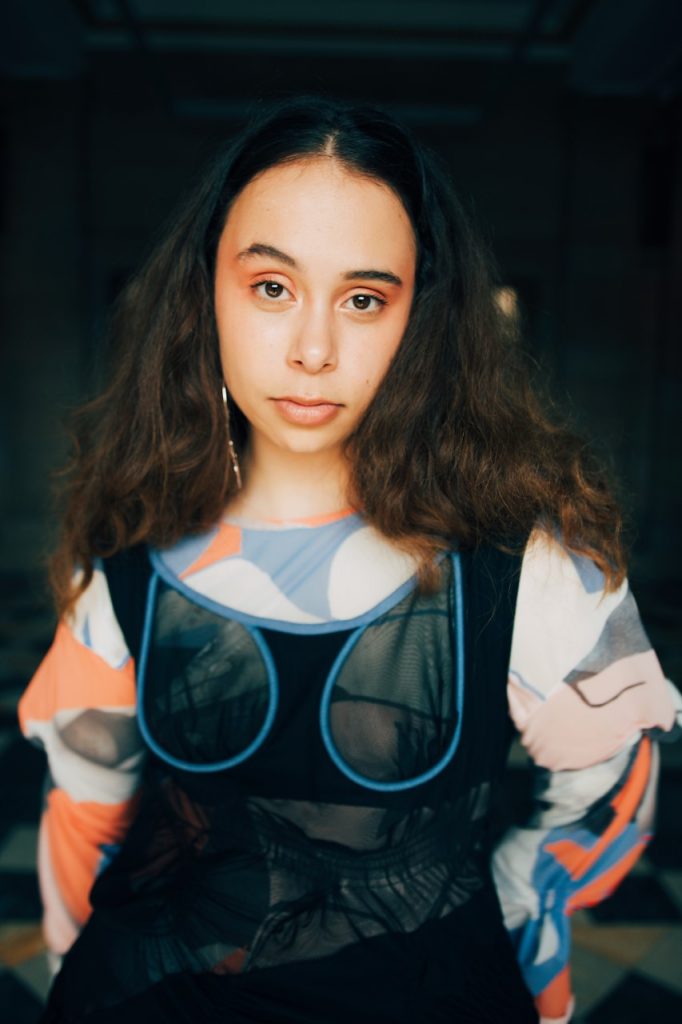
Layered dresses, by Katie Griffith Morgan
Power mesh, bamboo jersey, Edinburgh, 2019
Heriot Watt Collaboration: Pauline Lischke
Designer: Ellie Butler
Muse: Sophie Rees
I’ve taken inspiration from my muse’s love of travelling, and the journals and scrapbooks she kept over two years spent in places such as Thailand, Cambodia and Vietnam. I wanted to create something that reflected Sophie’s edgy yet effortless style, layering fabrics, using contrasting textures, and taking inspiration from the fashion and culture of the “underground eighties”.
Sophie is interested in the representation of petite models with diverse body types in the fashion industry. I wanted to play with proportion in my design, looking at longer sleeve and trouser length, to reinforce this idea of smaller models being under-represented.
Top, leggings and dress, by Ellie Butler
Stretch cotton jersey, power mesh, heavy cotton rib, Edinburgh, 2019
Heriot Watt Collaboration: Rebecca Cuthbertson, Nicole Masuku
Designer: Emma Davenport
Muse: Anthony Ani-Inang Ani
Anthony was born and raised in Nigeria with his parents and four sisters. The country’s vibrant culture is centred on community and family values, so I focused my research on the architecture that brings community together, from both my home town (Cambridge) and Anthony’s.
I explored surface texture by manipulating stretched denim to mirror construction lines, creating shape and volume in the fabric, and incorporating traditional African techniques of surface application. I researched wax resist dying (Nigerian Batik) methods and block printing (Ghanaian Adinkra). My final design is intended to reflect the relationship between Western and African contemporary fashion.
Jacket and Trousers, by Emma Davenport
Stretch Denim, Edinburgh, 2019
Heriot Watt Collaboration: Martyna Rumian
Designer: Eve Fallon
Muse: Maya Sajeev
Maya is a 2nd year international student from Mumbai. I chose to work with her to explore people’s experiences of different cultures.
I looked at the theme of belonging though the concepts of home and food – aspects which often encompass the idea of ethnicity, family and belonging. These were also the things that Maya missed most being away from home. For the concept of ‘home’ I researched Mumbai architecture – specifically Art Deco. I also explored Indian printing, creating a print based on some of Maya’s favourite Indian food.
Turtleneck, asymmetric jacket and skirt, by Eve Fallon
Rib knit, neoprene, stretch jacquard, Edinburgh, 2019
Heriot Watt Collaboration:Abbie Lee Baxter, Lois Rutherford
Designer: Issy Gutierrez
Muse: Yara Elias
My muse has both Saudi Arabian and Palestinian heritage, moving to Edinburgh from Dammam just 5 years ago. She is passionate about starting a conversation about the oppression and disregard the western world has for not only the people of Palestine, but people of colour generally.
My garment is about stability and reconnection. I have chosen to use the slogan “WE ARE HERE”, imposed in flocked vinyl. I wanted this message to be bold and powerful as slogans can be incredibly accessible to a large audience, and it holds an inescapable truth. The garment is a culmination of Yara’s edgy street style and my own interest in design for social change.
Multi-layered jacket and trousers, by Issy Gutierrez
Ponte, rib cotton, Edinburgh, 2019
Heriot Watt Collaboration: India Gill
Designer: Lucy Mitchell
Muse: Ellie Dora
I wanted to raise awareness of an issue close to me, skin positivity. I believe the media and the fashion industry play a vital role in the connotations that surround this issue, and that we should celebrate individuality. My muse, Ellie, has vitiligo – a condition that means pale white patches develop on the skin due to lack of melanin (a pigment in the skin).
The dress layered over the top of the slip is designed to reveal areas of the first dress and its spiral seam detailing. I also embroidered spiral patterns onto the garments, inspired by the beautiful imagery of Ellie’s skin.
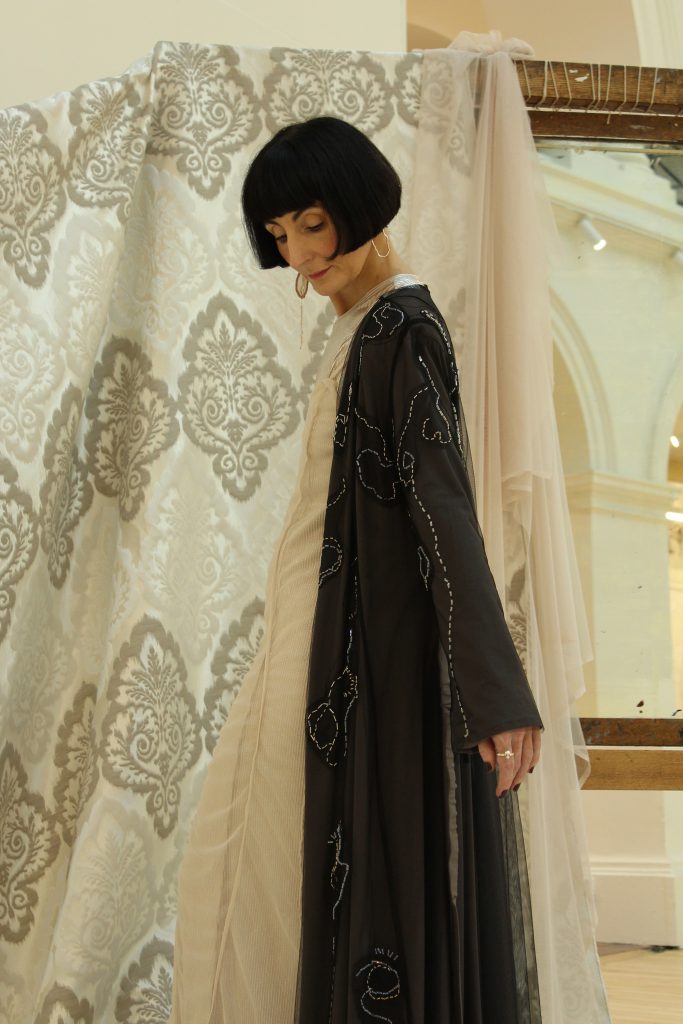
Jacket, dress and slip, by Lucy Mitchell
Power mesh, jersey, metallic plisse, Edinburgh, 2019
Heriot Watt Collaboration: Erin Kyle
Designer: Carmina Navarro
Muse: Roberto Antolin Sanchez
Roberto is a 41-year-old Spanish Research engineer, 5’5” tall with a size 32 waist. He has a congenital heart disease, which has affected his life in multiple ways since he was born. The condition, and the numerous surgeries Roberto has been through, has led to under-development and asymmetry in his body.
For the support and stability of the garments I was inspired by the benefits of Kinesiotape – a rehabilitative technique that uses the tension of tape to change muscle tone, correct movement, and improve posture without restricting the body’s natural range of motion. Details such as an extra strip in the right sleeve are intended to highlight the asymmetry of his body.

Jacket and trousers, by Carmina Navarro
Neoprene, rib knit
Heriot Watt Collaboration:Alita Childs, Ziyi Meng
Designer: Heather Reid
Muse: Margaret Rooney
My muse is my nana, a 70-year-old woman with an outspoken personality and a visual style that sets her apart from her age group.
Inspired by the pop art movement and visual culture of the 1960s, I explored animal prints and psychedelic patterns to reflect my nana’s fun-loving and wild spirit. I contrasted the clashing animal prints and feminist slogans on top with a classic black shift dress, to draw the eye to the statement coat.
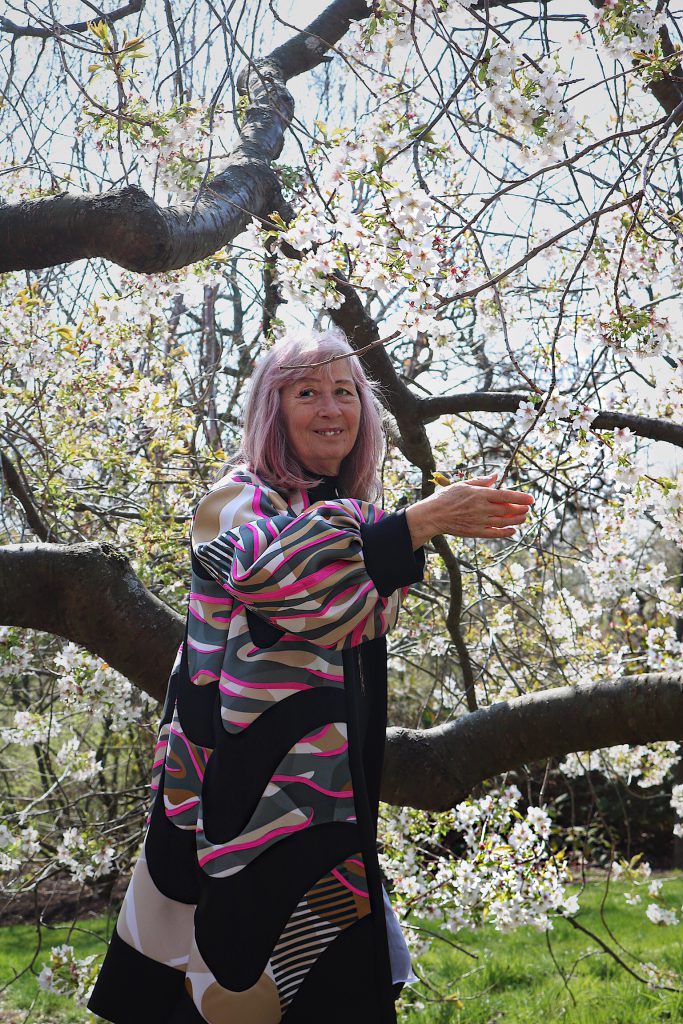
Graphic coat and dress, by Heather Reid
Neoprene, cotton jersey
Heriot Watt Collaboration: Olivia McGauley
Designer: Raiesa Salum Al-Kilaly
Muse: Mohammed ‘Momo’ El-Koubani
My project looked at what it means to be a black man in Britain, exploring the contrasting perception and realities of the black male experience. It considers dual identities – one being a traditional black male in Africa and the other growing up as a black male in London.
2-in-1 quilted coat and wrap skirt, by Raiesa Salum Al-Kilaly
Stretch nylon, Edinburgh, 2019
Heriot Watt Collaboration:Amy Owens
#BodyBeautifulExhibition
Discover how today’s fashion industry is challenging perceptions and championing alternative ideals of beauty on the catwalk, in advertising, editorial and behind the camera.
Body Beautiful: Diversity on the Catwalk is on at the National Museum of Scotland until 20 October 2019. It then goes on an international tour, next stop to the Textile Museum Sweden in February 2020.
